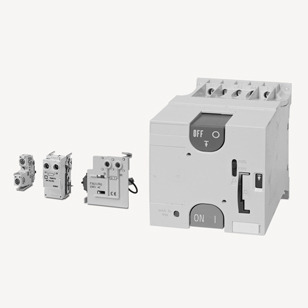Electrical Distribution
- Circuit protection devices
- Measurament Instruments
-
Isolators and comfort functions
-
Electrical Switches
- Modular switches ASV
- Modular isolators ASR
- Modular disconnectors HLN00, HLN0 up to 63A
- Modular disconnectors HLN1, HLN2 up to 200A
- Non-automatic MCCBs MC9 up to 1600A
- Loadbreak disconnectors HLN3, HLN4 up to 630A
- Loadbreak disconnectors HLN6S, HLN7 up to 1600A
- Loadbreak disconnetors HLN8S, HLN9S, HLN9 up to 4000A
- Motorised loadbreak disconnectors
- Loadbreak disconnectors with shunt trip device
- Fused loadbreak disconnectors
- Changeover Switches
- Push-buttons, Indication lamps
- Contactors, Relays
- Time Relays
- Time Switches
- Electrical Transformers
-
Electrical Switches
- Surge Arresters, Fuse holders
- Busbar system
- Accessories for breakers and isolators
- Photovoltaic electrical devices
Auxiliary contacts, releases and electrical operators
- General
- Documentation
Bell Alarm & Auxiliary Switch
The Bell Alarm switch is used to signal a breaker trip operation. Common uses for bell alarm switches include indicating lights, external control relays, interlocking schemes, and any other application that requires remote indication of breaker trip. The switches are available in either normally open (NO) or normally closed (NC) configuration. Auxiliary switch contacts hange position due to any operation of the circuit breaker (overcurrent trip, push to trip from the front cover, shunt trip/undervoltage release or toggle handle operation). Bell alarm contacts do not change position due to an operation of the toggle handle or push to trip button.
The auxiliary switch provides remote indication of the primary contact position. Auxiliary switches are commonly used anywhere remote indication of breaker position is desired. These switches are available in normally open (NO) and normally closed (NC) configurations; the contacts change position upon changing of position of the primary contacts regardless of method of operation.
Shunt Trip & Undervoltage Release
The shunt trip is used to remotely open the circuit breaker. Like all other accessories, the hunt trip is UL listed for field installation and does not require exposure to current carrying parts for installation. Both the shunt trip and Undervoltage Release are low power consumption devices. MC9 breakers feature a kiss-free design, which ensures that the primary contacts do not come into contact when a closing attempt is made with a shunt-trip or undervoltage release energized.
The undervoltage release is used to trip the circuit breaker when a control signal is removed, or drops below 35–70% of the rated voltage. If an attempt is made to re-close the circuit breaker without re-application of control power to the undervoltage release, the breaker will be held trip-free, preventing the contacts from closing.

Download
-
Quick Catalog [pdf] 5253 Kb
GR_MC9_14_R1_eng
Elettra - distributor of products for low voltage for automation and electrical distribution
Authorized distributor
Low Voltage & Industrial Automation products
Electric panels software
Ask for our Switchgears Design Software:
a valuable tool that is distributed free of charge to anyone who requests it
Contacts
Contact our Customer Service for any sales, marketing and technical question
049 8075544
From monday to friday 8.30 - 12.30am / 2.00 - 6.00pm
Elettra Srl
Via Lisbona 28A/5 - Zona Industriale Sud
35127 PADOVA
T. +39 049 8075544
F. +39 049 8077695
Copyright © 2025 Elettra Srl - Via Lisbona 28A/5
P. Iva e cod. fisc. 00629080284 - Registro imprese di Padova N. 10349 Vol. 15119 Capitale sociale 1.000.000 i.v.
Powered by 3spices




